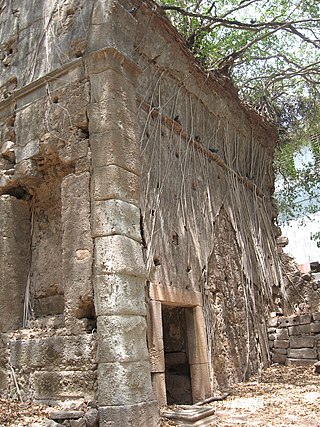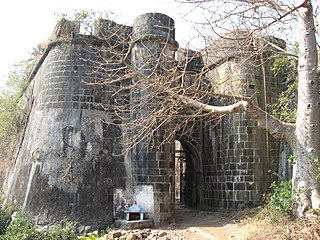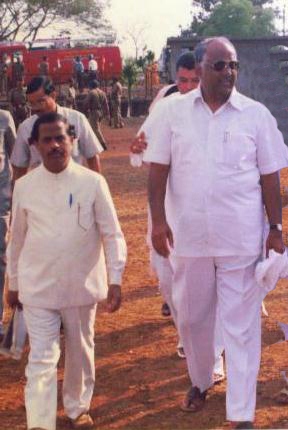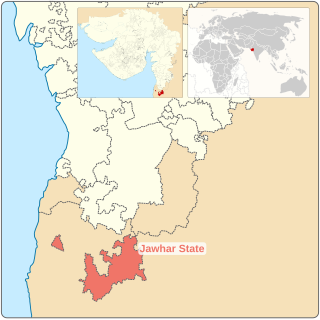Related Research Articles

Qutb-ud-Din Bahadur Shah, born Bahadur Khan was a sultan of the Muzaffarid dynasty who reigned over the Gujarat Sultanate, a late medieval kingdom in India from 1526 to 1535 and again from 1536 to 1537. He ascended to the throne after competing with his brothers. He expanded his kingdom and made expeditions to help neighbouring kingdoms. In 1532, Gujarat came under attack of the Mughal Emperor Humayun and fell. Bahadur Shah regained the kingdom in 1536 but he was killed by the Portuguese on board a ship when making a deal with them.
Bhima, also known as Bhimdev or Bimba-Shah, was a 13th-century Indian king (raja) who established his capital in Mahikavati, the present-day Mahim, in Mumbai. He is identified as a son of the king Ramadeva of Devagiri.

Jawhar is a city and a municipal council in Palghar district of Maharashtra state in Konkan division of India. Jawhar was a capital city of the erstwhile princely state of Jawhar. Situated in the ranges of the Western Ghats, Jawhar is known for its picturesque setting and a vibrant cultural heritage. It is one of the few remaining tribal regions of Maharashtra and is known for its vibrant Warli painting that are a characteristic landmark of this place. Established in 1918, Jawhar is one of the oldest municipal councils in the state of Maharashtra and tourist spot near Mumbai.
Indigenous tribals have inhabited Mumbai (Bombay) since the Stone Age. The Kolis and Aagri were the earliest known settlers of the islands. Between the 2nd century BCE and 10th century CE, the islands came under the control of successive indigenous dynasties: the Satavahanas, Abhiras, Vakatakas, Kalachuris, Konkan Mauryas, Chalukyas, Rashtrakutas, Silharas & Cholas.
The history of Mumbai under Islamic rule began in 1348 and continued until 1534.

Bombay, also called Bom Bahia or Bom Baim in Indo-Portuguese creole, Mumbai in the local language; is the financial and commercial capital of India and one of the most populous cities in the world. It's also the cosmopolitan city centre of the Greater Bombay Metropolitan Area, and the cultural base of the Bollywood film industry. At the time of arrival of the Portuguese Armadas, Bombay was an archipelago of seven islands. Between the third century BCE and 1348, the islands came under the control of successive Hindu dynasties. The Delhi Sultanate had been ruling the area along with Chaul, New Bombay (Thana) & Damaon; with the local administration at Bassein (Vasai) since the raids of Malik Kafur in the Konkan region and across the Indian subcontinent. This territory in North Konkan along with the Bombay islands were later taken over by the Sultan of Guzerat from 1391 to 1534, when he had declared the end of the suzerainty to Delhi, after the Timurid invasion of it. Growing apprehensive of the power of the Moghal emperor Humayun, Sultan Bahadur Shah of Gujarat was obliged to sign the Treaty of Bassein on 23 December 1534; according to which, the Seven Islands of Bombay, Fort San Sebastian of Bassein in strategic town of Bassein (Vasai), and its dependencies were offered to the Portuguese East Indies. The places were only later officially surrendered on 25 October 1535, by the Sultan of Guzerat.
Gerson da Cunha was an Indian advertising professional who was also a stage and film actor, social worker, and author. He headed the Indian market communications agency Lintas and also worked for J. Walter Thompson, and Hindustan Lever in a career spanning 25 years. He worked with UNICEF in Brazil and was awarded the Order of Rio Branco by the government of Brazil in 2018 for his services to that country.
William Aislabie was a British governor of the Bombay Presidency during the days of the East India Company.

Jath State, was one of the non-salute Maratha princely states of Deccan States Agency, one of the former Southern Maratha Jagirs. Jath State and Daphlapur State were the only two states belonging to the Bijapur Agency under the Bombay Presidency, which later became part of the Deccan States Agency.

The Jawhar State was a princely state in India. As a princely state, it became a part of Bombay Presidency during the British Raj. It was the only state belonging to the Thana Agency.
José Gerson da Cunha was a Goan physician who achieved international renown as an indologist, historian, linguist and numismatist.
Maloji Bhonsale was a Maratha Sardar who served as the Sargiroh of Ahmadnagar Sultanate. He was the father of Shahaji and the grandfather of Shivaji, the founder of the Maratha Kingdom.

The military history of Bassein encompasses the period from 1526, when the Portuguese established their first factory at Bassein, until 1818, when Bassein lost its strategic importance following the defeat of the Marathas by the British.

R.P. Mukne is an Indian politician. His full name is Rajaram Pandurang Mukne, popularly known as "Anna" or "Ramrao Mukane". He was President of Jawhar Municipal Council of Jawhar, a former Princely State. He was elected unopposed as a President of Jawhar Municipal Council. He is a leader of the Nationalist Congress Party (NCP). Mukne is lawyer by profession who has been appointed as secretary of the NCP for the state of Maharashtra. He is more social activist than a politician working for rural, Adivasi and needy people in Thane District from last 4 decades.

The Mahalakshmi temple, or Mahalaxmi Temple, is a temple situated on the Mumbai–Ahmedabad Highway in Dahanu taluka, Palghar, Maharashtra, India. It is dedicated to Mahalakshmi. This temple was built by Koli king Jayaba Mukne of Jawhar State in 1306 at the establishment of Jawhar. During the worship, the flag of the present Raja of Mukne Dynasty of Jawhar is offered to the mother's temple. The flag is presented by Narayan Satava, the priest of the village of Vaghadi.

Gambhirgad Fort is a fort located 58 km from Dahanu, Palghar district, of Maharashtra. This fort is less important fort in Palghar district. The fort is in ruins and restoration is to be done.

Mukne Dynasty or Mukane Dynasty was the ruling dynasty of the Jawhar State. Koli chief Jayabha Mukne founded it in the middle of the 14th century. It traces its origin from Mukane. The Mukne Dynasty ruled Jawhar for six hundred years, up until 1947.
The Maharaja Soma Shah was Koli ruler of the petty kingdom of Ramnagar, present days in Gujarat. He invented the Chauth system which was a form of the Protection fees.
References
- ↑ Cunha, Joseph Gerson Da; Cunha, Joseph Gerson (1876). Notes on the History and Antiquities of Chaul and Bassein. Thacker, Vining. p. 257. ISBN 9788120608450.
Jagappa Mukne.
- ↑ Nairne, Alexander Kyd (1988). History of the Konkan. Asian Educational Services. ISBN 978-81-206-0275-5.
- ↑ Dept, India Foreign and Political (1876). Bombay presidency. Re-printed at the Foreign Office Press.
- ↑ Selections from the Records of the Bombay Government. Government at the Bombay Education Society's Press. 1856.
- ↑ Tribhuwan, Robin D. (2003). Fairs and Festivals of Indian Tribes. Discovery Publishing House. ISBN 978-81-7141-640-0.
- ↑ Gazetteer of the Bombay Presidency: Tha'na (2 pts.). Government Central Press. 1882. p. 703.
Jayaba Mukne.
- ↑ Aberigh-Mackay, George (1878). The Native Chiefs and Their States in 1877: A Manual of Reference. Times of India Steam Press. p. 69.
Jayaba Mukna.
- ↑ "JAWHAR". members.iinet.net.au. Archived from the original on 2 October 2019. Retrieved 28 November 2019.